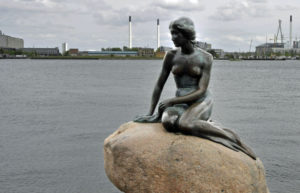
Little Mermaid Statue in Copenhagen Harbor (Photo by Don Knebel)
In 1819, Hans Christian Andersen, then 14, moved to Copenhagen, hoping to become an actor. When that did not work out, he began writing, publishing his first story at age 17. Initially focusing on fairy tales he had heard as a child, Andersen soon began writing the original stories now famous around the world, including “The Emperor’s New Clothes,” “The Ugly Duckling,” “The Snow Queen” and “The Little Mermaid.” In 1909, the son of the founder of the Carlsberg Brewery was so charmed by a Copenhagen ballet based on “The Little Mermaid,” a story about a mermaid who leaves the sea in search of a human soul, that he commissioned a statue of a mermaid using the ballerina as the model. When the ballerina refused to pose nude, the sculptor’s wife became the model for the body. In 1913, the four-foot-tall bronze statue was perched on a granite boulder on the waterfront in Copenhagen’s harbor, where it has become the symbol of the city, attracting a million admirers every year, both by land and by sea.
The Little Mermaid has been attacked repeatedly. She has lost her head twice and her arm once. She has been splashed or sprayed with paint at least five times, sometimes by groups who see the statue as degrading to women. On two occasions, the Little Mermaid has been dressed in Muslim clothes, once to protest Turkey’s effort to join the European Union. In 2003, the entire statue was blown into the water by explosives. The obvious deterrent of moving the statue further from shore has been rejected. A persistent rumor that the original statue is hidden away somewhere has never been substantiated.